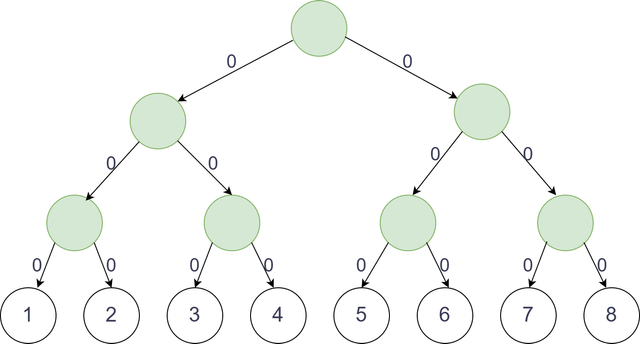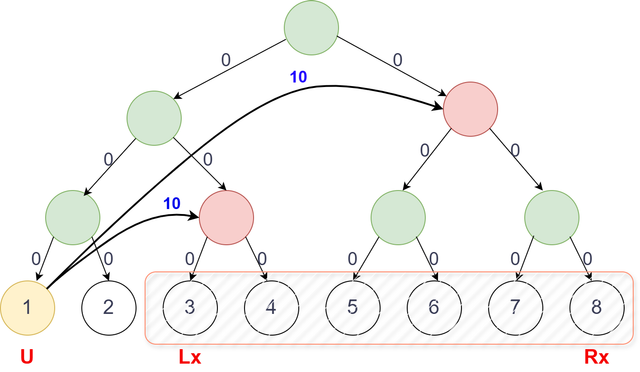- Recently I came across a new idea to solve graph-related problems using segment trees, I would like to discuss the same with a problem.
Problem:
Given a graph $$$G$$$ with $$$N$$$ nodes and many edges (around $$$O(N^2)$$$), Goal is to perform the Dijkstra algorithm on this dense graph and find out the shortest path cost from node 1 to all other nodes.
The edges are given in a compressed format. The input follows $$$M$$$ lines. Each of the $$$M$$$ lines consists of 4 integers U Lx Rx C meaning there are edges from node U to all other nodes in range [Lx , Rx] with cost C. Edges are uni-directional.
Example:
For N = 6 , the edge-group U = 1 , [Lx,Rx] = [3,5] , C = 10 looks like:

Constraints:
- $$$1 \le N \le 10^5$$$
- $$$1 \le M \le 10^5$$$
- $$$1 \le U \le N$$$
- $$$1 \le Lx \le Rx \le N$$$
- $$$1 \le C \le 10^9$$$
Do spend some time thinking about this problem, before proceeding to the solution.
Initial Thought Process:
The main problem faced here is that in the worst case, we have plenty of edges $$$O(N^2)$$$, performing Dijkstra in this dense graph would lead to time complexity $$$O(N^2 log(N))$$$ which would give TLE. Also, it is not possible to store all edges in the adjacency list, giving MLE.
So we need to seek out some ways to reduce the number of edges so that time complexity can be improved.
- Our solution proceeds like this, first we try to convert this dense graph to a sparse graph with less number of edges and then perform the Dijkstra Algorithm to find our answer.
- Since the input of edges is also given in compressed format, intuitively we can think that there might be some ways to represent a group of edges as a single edge, so that we can reduce the number of edges and solve our problem.
Solution: Segment Tree as a structure
- One main observation in this problem is that we add edges from node
Uto a range of nodes[Lx, Rx]. This gives an intuition that we deal with ranges and we can use segment trees to solve our problem. - In our solution, We only use the structure and ideas of segment tree (complete binary tree). We dont calculate or store anything in the segment tree nodes.
- First, we build a segment tree $$$G'$$$ with $$$N$$$ leaf nodes, ($$$2N$$$ nodes in total). These $$$N$$$ leaf nodes represent the $$$N$$$ nodes of the original graph $$$G$$$ and add edges from parent to its left and right children with 0 cost.
Example N = 8

- It is a well known fact that any range
[Lx , Rx]can be covered by $$$O(log(N))$$$ nodes in a segment tree. So for every edge-groupU Lx Rx C, we add edges from nodeUto these $$$O(log(N))$$$ nodes with costC.
Example: N = 8, U = 1, [Lx,Rx] = [3,8], C = 10

- Since from any intermediate node, we can visit the leaf nodes in its subtree with 0 cost, this graph $$$G'$$$ preserves the same information of graph $$$G$$$.
- Total number of edges is $$$2N$$$ (intial graph) + $$$M*logN$$$ (for each edge-group), So total edges are $$$E = O(Mlog(N))$$$.
- Performing dijkstra in this graph $$$G'$$$ would give time complexity $$$O(Mlog^2(N))$$$ which would pass under the given constraints.










Am I misunderstanding the problem or is it trivial to solve it in $$$O((n + m) \log{n})$$$ with $$$O(n + m)$$$ memory instead:
How are third type updates handled?
https://ideone.com/BBAbFa
Segtree node operations are in
InfoChanandTagChan.https://codeforces.net/contest/786/submission/289123812 ?
Ah nvm im clown you're refering to blog problem
I think you can probably do that, it's arguably a bit more difficult to code though, and you would have to maintain in each node how many nodes in it's subtree are toggled and how many are not. Also, the trick with weighted edges between different nodes inside a segment tree is really elegant in my opinion, so it was nice to see.
Yes, you are correct, we can store distances in a segment tree and build a min segment tree with lazy propagation. But this works only for this problem. I don't think that the practice problems can be solved with this strategy, I intended to just introduce this idea in a blog and felt this to be very elegant solution. But yeah other solutions exist.
The practice problem can also easily be solved in this manner, by just creating one more segment tree to handle type 3 queries 289128975.
Thanks
Nice blog! Here are some othe problems I've found that use this technique: Golf, Passport
Another similar problem: 1904F - Beautiful Tree
Another problem on this idea which I've seen ages ago (and still looking for some judge to be able to submit, if someone knows it, pls help).
$$$N$$$ mines are positioned on a line, each has its coordinate $$$x_i$$$ and radius of explosion $$$r_i$$$. When some mine explodes, all other mines in its radius explode. Then they can explode other mines and the chain reaction happens. Find for each mine the number of mines that will explode if you explode this manually. $$$N\leq 10^5, |x_i|, |r_i|\leq 10^9$$$.
Also this idea can be done on trees, you'll need centroid decomposition. A nice example is All-Russian Olympiad 2015, problem 8 (I don't think it exists on CF, here is the link to Russian statement)
https://codeforces.net/problemset/problem/1078/D
https://open.kattis.com/problems/canofworms
Thanks, that’s it!
Yeah, it is a cool trick! I love it! So this makes a graph with $$$O(n)$$$ vertices and $$$O(n + m \log n)$$$ edges. Instead of a segment tree, one can also build a sparse table (disjoint if needed) on top of the vertices to get $$$O(n \log n)$$$ vertices and $$$O(n \log n + m)$$$ edges. It could be advantageous if $$$m » n$$$. Basically, it's the same idea. But when I saw it in the context of sparse tables, I understood how general it could be.
Problem: 1602D - Frog Traveler
Solution: 133095322
Wow!!! I rally like your idea to represent range of nodes as a node of segment tree. Very nice ways of problem solving
thanks, i hope i reach pupil after this blog.
This is a really nice idea. I remember seeing it at our IOI preparation last year and I am really happy that I was able to come up with it myself while solving problem CSA — Field Activation (in 1 dimension).
Another great example of the idea is
Sopsug
I've been struggling with B — Legacy for a really long time, and now i come across this blog. What a saviour of my life ! Thanks
Here is another source mentions this technique:
https://robert1003.github.io/2020/02/14/graphs-and-segment-tree.html